Episcias are very fast, vigorous growers. This makes them very easy to grow but also means that they can quickly become overgrown and “weedy” looking if neglected and not regularly groomed. By grooming, we mean removing unnecessary leaves and stolons and repotting, if necessary. For more detailed instructions on repotting episcias, see our lesson on this subject.
Should you have a desire to grow an episcia for exhibition (a “showplant”), this is something you’ll have to do. Even if not grown for show, however, proper grooming is still desirable simply because it makes your plant more attractive.
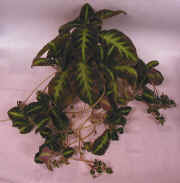
The episcia before grooming.
Shown at left is Episcia ‘Blue Nile’, a very easy to grow variety that will produce blue flowers. This one is shown in a 6″ pan-pot and has been neglected for quite some time. Other than providing it with light and water, we haven’t groomed it in about three months.
Notice the number of long stolons, and stolons off of stolons. This is one reason it’s not blooming. Episcias (and most plants) bloom better when their foliage growth is controlled–this plant has spent its energies on producing leaves and stolons, not blooms.
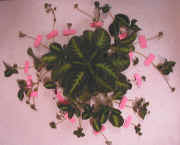
Step 1: Remove unnecessary stolons.
This is the plant viewed from above. It has a tremendous number of stolons, most of which aren’t necessary. We’ll keep only the most well-developed stolons, and eliminate those tiny, secondary ones. Those to be removed are marked in pink.
We would rather have fewer, but better developed, stolons than many, tiny, undeveloped ones. Also, this will encourage the plant to bloom since you’re not allowing it to reproduce itself vegetatively (by stolons). Growers who find episcias to be stubborn bloomers often make this mistake.
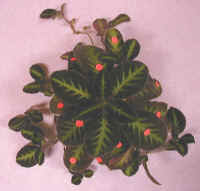
Step 2: Remove unnecessary leaves.
This is the same plant after having many of its stolons removed. Our next step is to remove all of the unnecessary leaves. Those to be removed are marked in orange.
Notice that leaves being removed are paler, and not as healthy looking those being kept. Notice also that the leaves we are removing are the oldest, growing lower on the plant stem and often are hidden beneath younger growth above them.
We have a saying, “if you want the new to grow, you need to eliminate the old”. By removing old, more of the plant’s energies will go into producing new growth.
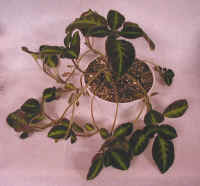
Step 3: The “pruned” plant.
This is the same plant after we have removed all of the unnecessary stolons and foliage! All that remains is the newest growth of the main crown, and the primary, most developed, stolons.
Admittedly, this plant seems to look much worse than when we began. Don’t worry, “ugly now means pretty later”. Of course, it still needs to be repotted. We’ll put it up into a 8″ pan (shallow) pot, bury the main stem, and arrange and pin the stolons.
Again, for instructions on how to bury the stem, see our repotting lesson.
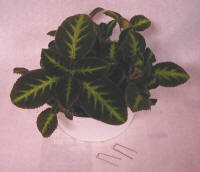
Step 4: The repotted plant.
Here’s our plant after repotting. We’ve used an 8″ pot and arranged the stolons to fill in the empty spaces. Using “U-pins” (seen below pot), we’ve pinned the stolons into the soil surface. Soon these will root and begin to produce stolons of their own.
Once the plant gets comfortable in its new pot, and begins to produce new roots and foliage, it will have an even healthier, fuller look. Also, by limiting the production of stolons, it will bloom sooner and more heavily than it would have. Within a couple of months, we’ll have a specimen worthy of showing.
10 COMMENTS
- ElenaNovember 29, 2019 2:33 pmReceived my shipment of episcias. The first one I opened had one flower. I was very impressed with the wrapping and I figured that only one that loved (his/her) babies could do that. Would I order again from your business? Absolutely yes. Thank youReply
- Ellen GannuchOctober 7, 2019 6:02 pmI’ve grown episcias for years. However, my episcias are producing stolens with extremely tight stolen leaves and they are drying up. What is wrong, and what can I do?Reply
- Violet BarnOctober 21, 2019 2:36 pmThere could be many causes. Episcias do prefer humidity, so dryness, especially combined with heat, can cause this. Inconsistent watering may as well, or any other stress to the plant. If the stolons are not attractive, you can remove them. Your plant should produce more and will bloom better with few of them anyway.
- Johnnetta SmithJuly 9, 2019 2:24 pmCan you reproduce using the stolon’s you’ve cut away?Reply
- Violet BarnJuly 19, 2019 8:46 amYes. This is the easiest way to propagate episcias and is what we do.
- Linda VaughnMarch 17, 2019 5:50 pmMy new plant friend highly recommended Violet Barn and the Episcia is one of her favorites. I ordered today and look forward to receiving my plants. Thank youReply
- Edward ResendesOctober 3, 2016 10:58 pmA couple of months ago I bought two episcia plants from you. When they arrived, one was slightly bigger than the other. I treated them the same. The larger of the two has tripled in size, the other hasn’t grown at all. Any new growth shrivels up and dies. What is the cause of this?Reply
- Violet BarnOctober 4, 2016 9:41 amNeed to know much more information than this. Like children, not all plants are the same, so treating them the same doesn’t necessarily produce the same results. Need to know the variety, care, and environment. For a proper diagnosis, best to call us during business hours so we can ask the proper questions.
- Diane KrauseJuly 10, 2016 1:50 pmI recently bought several violets from you. The packaging was excellent. Arrived in wonderful shape.
Question: Can I plant several different violet plants in one large pot?Reply- Violet BarnJuly 11, 2016 4:39 pmYou may, but episcias grow and spread quickly so they may become crowded in the container if potted together. If you do this, you may want to limit the amount of stolons that each plant produces. This will also give you more blooms.
